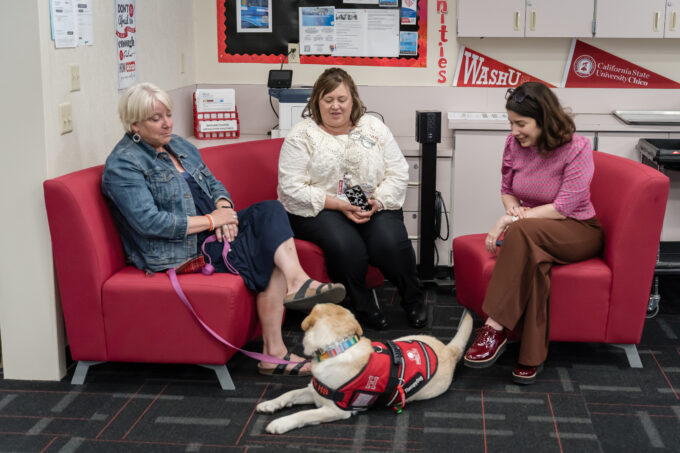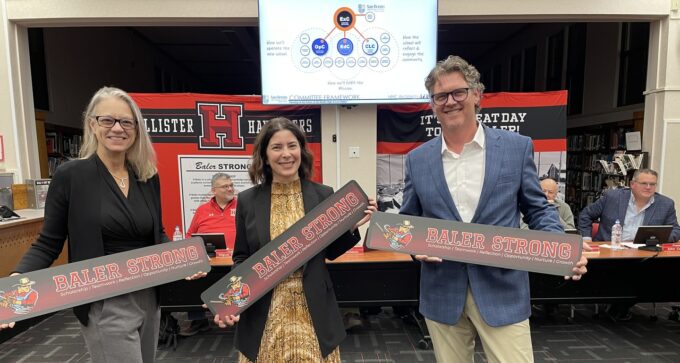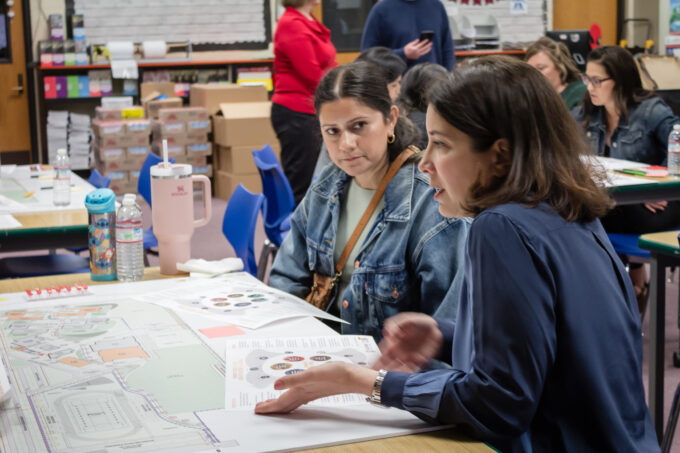Welcome to HMC Architects’ Five in Focus blog series, where we delve into the latest trends, ideas, and innovations shaping the future of architecture and design. This series is a conversation with our design professionals, inviting them to share what’s capturing their attention and offer unique insights.
Sherry Sajadpour, AIA ALEP is a PreK-12 principal in charge. Here, she shares her thoughts on declining PreK-12 enrollment, mental wellness and school pet therapy programs, migrant education programs, AI as a creative partner, and the AIA’s Women’s Leadership Summit.
1. Declining Enrollment
In July, our A4LE Northern California/Nevada Chapter assembled a fantastic virtual bi-annual School District Challenges Panel Discussion Series where we heard from three local districts who shared their challenges with enrollment swings, Santa Ana Unified School District, Lake Tahoe Unified School District, and Chico Unified School District. I’ve also been following and hearing more on this topic, school closures, and shifts in enrollment. Of course, there are many factors contributing to the decline, Santa Clara County for example cites rising housing costs and the overall higher cost of living. Families in that district are leaving to find a lower cost of living and more affordable housing options in other regions such as Hollister or even out of state.
What was interesting to me was that all three districts in the panel touched on being nimble with their approach and are considering that their traditional standards may no longer be the way to go. They spoke about “right sizing” each school, actively listening to the community and parent needs, and looking at the school’s design from their perspective and what would draw them. Santa Ana School District shared that to combat declining enrollment at Century High School, they introduced a new Esports program, transformed four otherwise empty classrooms, and turned them into a learning, creating, and competition space. Lake Tahoe Unified School District also transformed some of its underused space into a community space, which has been a huge hit with the respective communities while also making the best use of underutilized spaces. All the districts echoed that by right sizing their campuses, they could create spaces and programs that attract students, change configurations to expand the offerings, provide community support services, and improve spaces to support programs while filling the underutilized spaces based on specific needs. When navigating declining enrollment and designing for current needs, it’s important to be flexible and adaptable and look for ways to respond to current needs using the underutilized spaces.
2. Mental Wellness in Schools and Pet Therapy
We’re seeing more focused attention on mental wellness all around us, and it’s great to see more and more programs in schools provide accessible resources to help our students thrive academically and emotionally. However, it’s not one size fits all, or accessible and attainable at all schools. Recently I’ve watched as multiple schools add therapy pets to their regular routines to help students deal with stress, process mental health concerns, and boost academic engagement. Our home school has five dogs each of which visits the school on certain days of the week.
Therapy dogs are not just helpful for K-12 students but for those pursuing higher education as well. Having a labradoodle, the healing power of dogs has always been of interest to me, so I’ve been following the stories of Dash, a therapy dog at Gateway Community College who offers students support and joy around campus. Seeing this concept implemented beyond elementary to community colleges is very interesting mainly because I see this as a cost-effective way in which everyone can have access, without hesitation or feeling judged!

Sherry (Right) and Hollister High School’s therapy dog Scout
3. Migrant Education Programs’ Impact on Student’s Lifestyle
I am currently working on a project for San Benito High School where I was introduced to their Migrant Education Program and a student population that has since intrigued my attention. Having moved a lot during my school years I thought I could relate. But for these migrant students, their life goes far beyond a few moves. These seasonal farmworker families have to travel and move from harvest to harvest from Texas to Arizona to California often multiple times a year.
The Migrant Education Program (MEP) is a Federal program for migratory students in schools that provides supplemental resources aimed at helping students achieve academic success. School staff coordinates resources, including the identification and recruitment of migratory children to the program. This program must be planned and designed with the involvement of parents and teachers and involves heavy participation of counselors and families.
To realize the significance of this group, today the Migrant Education Program provides academic support to around 300,000 migratory kids and these are just the ones that have enrolled in the program. For a second, imagine constantly being the new kid: new teachers, new friends, finding classrooms in new schools. Children may struggle to adapt to new school systems and may have lower graduation rates and less access to postsecondary education than other students. They may also lack English language proficiency or require remedial instruction. They may also experience emotional distress from frequent moves and family separation.
This has been at top on my mind since we started the San Benito High School project. As I’m doing my research and learning through our current project, I am constantly wondering how we can elevate our planning and design process to support the educational experience of this highly mobile population and address their specific needs through school design. More to follow in HMC’s Q4 issue of School News!
(To better understand the needs of this population, check out the movie A Million Miles Away about the astronaut Jose Hernandez who grew up as a farm worker)

4. AI as a Creative Partner
According to the Royal Institute of British Architects, although AI is newly accessible to the general public, “AI adoption in practice stands at 41 percent,” and “significant numbers of practices report that they are using AI for at least the occasional project.” (RIBA 2024 AI Report, 2024)
The two main areas I’ve personally seen it used are design ideation and text generation. We recently gave AI a try for graphic creation while another team member was simultaneously generating ideas. I must admit while AI can quickly produce multiple iterations, it lacks the emotional touch and the essence of human creativity. I see AI not as a threat, but as a tool that offers valuable suggestions and alternatives. However, it is the architect’s creative judgment that directs the selection and refinement of those possibilities. I believe we offer a deep understanding of how people engage with spaces, drawing on personal experiences and cultural contexts to create designs that connect on a deeper level.
I’ve been wondering about other ways we can utilize AI as a creative partner, to test our designs, quality control documents, and simulate use scenarios. Our technology and digital practice teams are currently exploring automation strategies in simulating emergency response scenarios. It would be interesting to learn more as we explore how AI will play a role in creating safe and secure environments.
5. Women’s Leadership Summit Awareness!
With the American Institute of Architects (AIA) Women’s Leadership Summit just around the corner, I wanted to use this opportunity to share a bit about this annual event. “Women’s Leadership Summit (WLS), founded by AIA, is a premier leadership experience that brings together the industry’s largest network of women who are breaking down barriers, making themselves visible, and manifesting the careers they want—while making a difference in the world.”
This year’s theme is building resilience—the ability to adapt to an ever-changing landscape, recover from setbacks, and persevere through difficult times.
WLS is not like other conferences. It is unique in the sense that it brings the largest group of women in the industry together to deliver essential leadership training designed to help women unlock their full potential. The conference aims to empower women to make a meaningful impact. As an active member of the Silicon Valley WIA chapter and an advocate for female leadership in the field, I have always been involved in the Summit in varying degrees, facilitating WIA sessions or connecting with speakers to share back with our local WIA. It’s been inspiring and motivating, and I’ve learned so much while establishing valuable connections, and exposure to successful women leaders. This year is no different, I appreciate HMC’s ongoing commitment to diversity and equity, for providing opportunities for professional development focused on emerging female leaders, providing the resources in leadership skills, and for the motivation and inspiration we all need to be better leaders. A few of us are attending the event in October, I’m looking forward to sharing what we’ve learned with our internal WIA following the event in the coming months.

